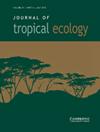Functional and phylogenetic metrics to evaluate the potential of flagship species: the case of the salamander Ambystoma ordinarium
IF 1
4区 环境科学与生态学
Q4 ECOLOGY
引用次数: 0
Abstract
Flagship species are those chosen to raise support for broader conservation marketing campaigns and can be used as symbols of the ecosystem services and evolutionary history of particular areas. Thus, flagship species can be employed for the protection of endangered species and threatened ecosystems. Northeastern Michoacán, Mexico, is an important region for amphibian diversity but approximately 40% of its mature forest has been removed. Among northeastern Michoacán amphibians, the use of评估旗舰物种潜力的功能和系统发育指标:以蝾螈Ambystoma ordinarium为例
旗舰物种是那些被选来支持更广泛的保护营销活动的物种,可以作为特定地区生态系统服务和进化历史的象征。因此,旗舰物种可用于保护濒危物种和受威胁的生态系统。墨西哥东北部Michoacán是两栖动物多样性的重要地区,但大约40%的成熟森林已被砍伐。在东北Michoacán两栖动物中,Ambystoma ordinarium作为旗舰物种与其他受威胁的两栖动物在河岸地带共存是支持的。然而,为了支持这一观点,有必要评估与普通水蚤共享栖息地的两栖动物物种的功能特征和进化史。为了评价普通水蛭作为旗舰物种的潜力,我们对60个河岸带两栖动物群落的功能和系统发育多样性进行了评估。结果表明,与普通水蛭共用栖息地的水蛭群落比无该物种的水蛭群落具有更高的功能和系统发育多样性。这些结果表明,在两栖类相关物种的保护、功能和进化历史等方面,扁叶藻有作为旗舰物种的潜力。
本文章由计算机程序翻译,如有差异,请以英文原文为准。
求助全文
约1分钟内获得全文
求助全文
来源期刊

Journal of Tropical Ecology
环境科学-生态学
CiteScore
2.10
自引率
0.00%
发文量
44
审稿时长
18-36 weeks
期刊介绍:
Journal of Tropical Ecology aims to address topics of general relevance and significance to tropical ecology. This includes sub-disciplines of ecology, such as conservation biology, evolutionary ecology, marine ecology, microbial ecology, molecular ecology, quantitative ecology, etc. Studies in the field of tropical medicine, specifically where it involves ecological surroundings (e.g., zoonotic or vector-borne disease ecology), are also suitable. We also welcome methods papers, provided that the techniques are well-described and are of broad general utility.
Please keep in mind that studies focused on specific geographic regions or on particular taxa will be better suited to more specialist journals. In order to help the editors make their decision, in your cover letter please address the specific hypothesis your study addresses, and how the results will interest the broad field of tropical ecology. While we will consider purely descriptive studies of outstanding general interest, the case for them should be made in the cover letter.
 求助内容:
求助内容: 应助结果提醒方式:
应助结果提醒方式:


